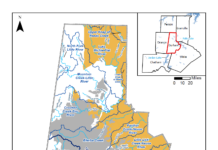Bowling Green, Kentucky, is a rapidly growing city of 75,000 people built entirely on a well-developed karst plain, upon which the natural drainage of the area flows to the Barren River via sinkholes, sinking streams, underground rivers, and caves developed in the underlying limestone.1 This natural hydrologic system presents a variety of challenges for development and urban planning, not least of which is the cover collapse sinkhole. Cover collapse sinkholes form when the soils overlying karst groundwater systems collapse into voids in the rock. These particular geohazards are common in the karst areas of Kentucky.2
As water moves into the underground streams carrying water through the area, it carries some of the soil into the caverns below. This creates a void beneath the surface but above the bedrock, supported only by the strength of the soil itself. Over time, the layer of soil between the void and the surface thins, and eventually it will collapse, leaving a steep-walled, hazardous hole in the ground (Figure 1).3 The size of these features can range from less than a meter to greater than 10 meters in diameter and depth, depending on soil thickness and the characteristics of the local bedrock.

Collapses are most commonly associated with rain events, which can make the local clay soils heavier and alters their mechanical properties. Another key factor in many cover collapse sinkholes is drainage infrastructure, which when compromised can cause water to pond or leak directly into the soil below surface (Figure 2). Many stormwater injection wells turn into sinkholes after clogging up, as water finds its way around the clogged hole into the groundwater system. Additionally, the removal of grass and other vegetation during construction decreases the strength of soil at the surface, and many collapses occur during the earthmoving phase of projects (Figure 3).
Per ordinance the city is responsible for repairing sinkholes occurring in the right of way of a city street or in a drainage easement within single or two family residential areas; in all other areas, the property owner is responsible for repairing the sinkhole. While some smaller sinkholes are repaired by city work crews, large ones are generally contracted out. Since 2016, the city has bid out a contract for sinkhole repairs every three years. More than 60 sinkholes have been repaired under the sinkhole contract. Additionally, sinkhole repair is a common corrective action noted in regulatory inspections of commercial stormwater infrastructure.

Most repairs performed are some variation of the concept shown in Figure 4:
- The sinkhole is excavated until the “throat” (the hole in the bedrock that water and soil are flowing into) is exposed.
- The sides of the hole are enlarged to remove all unstable material (commonly called the “wash”).
- Geotextile fabric is used to cover all exposed soil in the excavated pit.
- Crushed stone, beginning with boulders large enough to not fall into the throat, is added to the hole.
- The size of rock added is decreased as the hole is filled toward the surface and compacted with heavy equipment.
- Once the stone infill is near the adjacent grade, the fabric can be closed to encapsulate the stone “plug” and then either clay or topsoil can be placed over it, or a run of smaller stone to ensure drainage.


One of the realities of drainage work in karst areas is the lack of surface streams to convey stormwater runoff. In order to mimic the natural hydrologic system, the city and developers often drill stormwater injection wells to route runoff into the subsurface, where it would have naturally drained to prior to construction of impervious surface areas. In most cases, a cover collapse sinkhole will outperform a drilled well and is thus desirable as a drainage feature. In one specific example, a drilled injection well accepted no water whatsoever, but a cover collapse sinkhole 150 meters away on the same property accepted 40L/s. In situations like these, the cover collapse sinkhole can be modified, or “improved” in our terminology, to serve as a stormwater injection structure. Figures 4 and 5 show the standard and improved sinkhole drain designs, but the structure can be modified to fit the situation. The intent of these structures is to utilize the natural feature for drainage while minimizing the erosive potential at the sink point. Many improved sinkhole drains have been in use for several decades (Figure 6).
Simpler methods of sinkhole repair see some limited usage. Filling the hole with coarse crushed stone (cobbles 15cm and larger) can in some cases stabilize a sinkhole and temporarily remediate the immediate hazard. Generally speaking, this does not resolve the issue — between settling of the stone into the caverns below to erosion of soil at the edge of the stone infill, this method is not a permanent solution. Another method of repair is to cap or plug the hole, either with compacted clay soil in 0.3-0.6m lifts or with concrete. This method can be effective as long as the water previously draining through the sinkhole has an alternate drainage path available, as in the case of sinkholes that form around clogged storm drains or leaking pipes once the infrastructure is repaired or unclogged. However, if water does not have a planned route out of the area, new drainage issues can ensue.

Many cover collapse sinkholes are preventable. Since these collapses often occur in areas recently cleared for development, minimizing development footprints can reduce the likelihood of a sinkhole collapse. Areas in which water stands for prolonged periods can also develop into cover collapse sinkholes; ensuring that stormwater is drained off to designated retention areas at least minimizes the occurrence outside of the retention basins. Additionally, regular maintenance of stormwater infrastructure to prevent clogging and leaks can reduce the likelihood of a cover collapse sinkhole.
To date, the city has not undertaken a comprehensive assessment of sinkhole repair methods. To rectify this, throughout the course of 2023, city staff will inspect all repairs previously completed under the sinkhole contract, as well as those performed as corrective actions to notices of violation in the same term. Once these inspections are completed, a report will be compiled and all appropriate guidance documents updated.
References
Center for Cave and Karst Studies, 2006. “Karst Groundwater Flow in the Vicinity of Bowling Green, Kentucky.” Groundwater flow map prepared for municipal agencies of Bowling Green and Warren County, Kentucky.
Currens, JC, 2018. “Characteristics of Cover Collapse Sinkholes in Kentucky.” Kentucky Geological Survey Report of Investigations 3 (Series XIII).
Waltham, AC and Fookes, PG. 2005. “Engineering classification of karst ground conditions.” Speleogenesis and Evolution of Karst Aquifers, 3(1): 1 – 20.
About the Experts
Nick Lawhon, PG, CFM is the environmental compliance coordinator for Bowling Green (KY) Public Works, working primarily on MS4 and CVIW compliance, as well as being BGPW’s “holes-in-the-ground guy.” Courtenay Howell is the environmental compliance inspector for Bowling Green (KY) Public Works, focusing on construction site stormwater runoff compliance for the MS4 program. She serves on the IECA MS4 Management Education Track Committee and the Kentucky Stormwater Association Board of Directors.













